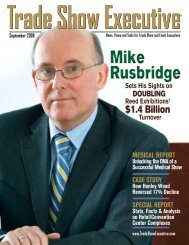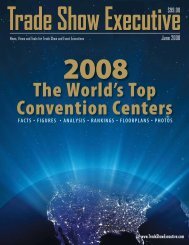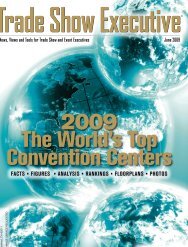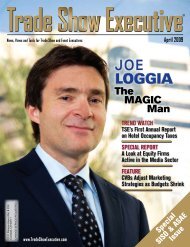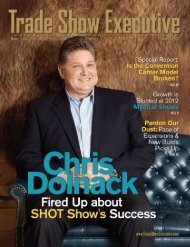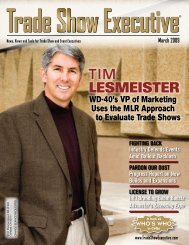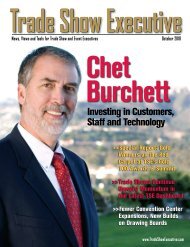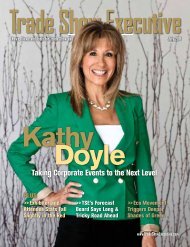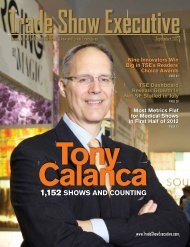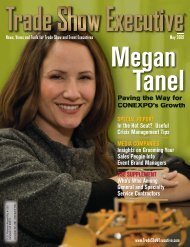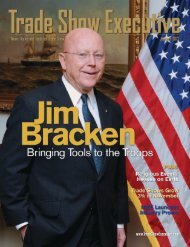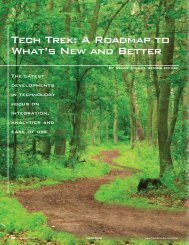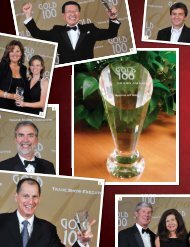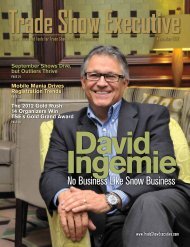the May 2008 Issue in PDF Format - Trade Show Executive
the May 2008 Issue in PDF Format - Trade Show Executive
the May 2008 Issue in PDF Format - Trade Show Executive
Create successful ePaper yourself
Turn your PDF publications into a flip-book with our unique Google optimized e-Paper software.
Power Lunch<br />
Bob: You’re a successful entrepreneur,<br />
yet you started <strong>in</strong> <strong>the</strong> research side of<br />
our bus<strong>in</strong>ess. How did you make that<br />
transition?<br />
John: As an English major graduate of<br />
Boston College, I quickly learned that<br />
<strong>the</strong>re weren’t any jobs for people who<br />
could quote Shakespeare. Dur<strong>in</strong>g my<br />
student days, I worked for my fa<strong>the</strong>r,<br />
who was a college professor of research<br />
methods and statistics. This gave<br />
me a practical background <strong>in</strong> market<br />
research, and one of my first jobs was<br />
with Cahners Publish<strong>in</strong>g Company as<br />
research assistant to Ira Siegel. He was<br />
ano<strong>the</strong>r mentor, and I soon relocated to<br />
New York when Cahners began buy<strong>in</strong>g<br />
magaz<strong>in</strong>es <strong>the</strong>re.<br />
Bob: Describe your experiences with<br />
Cahners Publish<strong>in</strong>g?<br />
John: It really sharpened my research<br />
skills. I must have worked for 17 different<br />
<strong>in</strong>dustries <strong>in</strong> <strong>the</strong> Cahners portfolio:<br />
<strong>in</strong>terior design, library, book publish<strong>in</strong>g<br />
and medical publications among <strong>the</strong>m. I<br />
knew just enough about each of <strong>the</strong>se to<br />
get through a ten-m<strong>in</strong>ute cocktail party<br />
conversation before people found me out.<br />
Bob: When did you first meet Bob<br />
Krakoff?<br />
John: I met him while I was work<strong>in</strong>g for<br />
R. R. Bowker which had been acquired<br />
by Cahners. Bob and Ira subsequently<br />
felt that I should br<strong>in</strong>g my market<strong>in</strong>g<br />
expertise to Cahners Exposition Group <strong>in</strong><br />
Stamford, CT. So I packed my research<br />
bag and moved <strong>the</strong>re.<br />
Bob: Was this about <strong>the</strong> time when<br />
CEG was acquired by Reed Elsevier and<br />
became Reed Exhibitions?<br />
John: Yes, soon after I relocated. I<br />
spent five years with Reed and loved<br />
every m<strong>in</strong>ute of my association with<br />
<strong>the</strong> company. I had a great boss, Neil<br />
Perlman, whom I knew from <strong>the</strong><br />
publish<strong>in</strong>g side. His roots were with<br />
Publishers Weekly, and he was promoted<br />
to head up <strong>the</strong> exhibition division. He<br />
pushed me <strong>in</strong>to market<strong>in</strong>g, direct mail,<br />
etc. Jim Alic succeeded him and gave<br />
me my first l<strong>in</strong>e management experience<br />
with <strong>the</strong> packag<strong>in</strong>g and pharmaceutical<br />
manufactur<strong>in</strong>g shows. It was a blast.<br />
Bob: Why did you leave?<br />
John: I’d relocated five times <strong>in</strong> ten years<br />
and decided to shop my resume with<br />
<strong>the</strong> <strong>in</strong>tent of settl<strong>in</strong>g back <strong>in</strong> Boston. I<br />
met a fellow Boston College alumnus,<br />
Jack Connors, who owned a successful<br />
advertis<strong>in</strong>g agency. He gave me <strong>the</strong><br />
opportunity to start my own trade show<br />
bus<strong>in</strong>ess, with <strong>the</strong> proviso that I develop<br />
a concept and <strong>in</strong>vest my ‘sweat equity.’ He<br />
would provide <strong>the</strong> capital.<br />
Bob: Sounds like a w<strong>in</strong>-w<strong>in</strong> opportunity.<br />
John: Yes, but I was reluctant. He<br />
challenged me to take <strong>the</strong> chance and<br />
rem<strong>in</strong>ded me that if we failed, I’d be<br />
<strong>in</strong> my mid-thirties and still marketable<br />
to o<strong>the</strong>r employers. I was scared, but I<br />
did it – and M/C Communications was<br />
launched.<br />
Bob: What was your <strong>in</strong>itial strategy?<br />
John: We had two parallel tracks: one<br />
was to get management contracts for<br />
exist<strong>in</strong>g events and <strong>the</strong> o<strong>the</strong>r was to<br />
launch our own events. As luck would<br />
have it, Terry McDermott, who was<br />
president of Cahners Publish<strong>in</strong>g USA,<br />
had left to become chief executive of<br />
<strong>the</strong> American Institute of Architects.<br />
He asked me to manage his AIA trade<br />
show and conference. This gave us our<br />
start and Terry cont<strong>in</strong>ues as a friend and<br />
mentor.<br />
Bob: How did you start your medical<br />
conferences?<br />
John: Soon after <strong>the</strong> AIA contract, we<br />
came up with <strong>the</strong> Pri-Med concept, which<br />
is shorthand for Primary Medic<strong>in</strong>e Today. It<br />
is a conference and exhibition for doctors<br />
and cl<strong>in</strong>icians <strong>in</strong> <strong>the</strong>ir local area that puts<br />
toge<strong>the</strong>r multiple primary care discipl<strong>in</strong>es<br />
and delivers world-class education. The<br />
first event was <strong>in</strong> Boston with Harvard<br />
Medical School as our partner. We had<br />
an exhibitor/sponsor advisory committee<br />
composed of all <strong>the</strong> major pharmaceutical<br />
companies, who paid for <strong>the</strong> opportunity<br />
to access doctors away from <strong>the</strong>ir hectic<br />
workplaces.<br />
Bob: Was <strong>the</strong> event successful?<br />
John: S<strong>in</strong>ce doctors constantly need<br />
cont<strong>in</strong>u<strong>in</strong>g education credits, our first<br />
conference drew a respectable 3,600<br />
attendees, with 120 exhibit<strong>in</strong>g companies.<br />
We didn’t make money, but Harvard<br />
loved it, our exhibitors loved it, and most<br />
importantly, <strong>the</strong> doctors loved it. The<br />
next year, 5,000 doctors attended Pri-Med<br />
<strong>in</strong> Long Beach, CA. Currently, <strong>the</strong>re are<br />
seven large Pri-Med conferences annually,<br />
with Harvard Medical School as partner.<br />
We also developed Pri-Med Update Meet<strong>in</strong>gs<br />
for <strong>the</strong> secondary and tertiary markets,<br />
respond<strong>in</strong>g aga<strong>in</strong> to <strong>the</strong> <strong>in</strong>creased need<br />
for cont<strong>in</strong>u<strong>in</strong>g education for doctors.<br />
Pri-Med is now held <strong>in</strong> n<strong>in</strong>e countries and<br />
comprises over 200 medical conferences<br />
each year.<br />
Bob: What about competition from <strong>the</strong><br />
Cont<strong>in</strong>ued on page 40<br />
www.<strong>Trade</strong><strong>Show</strong><strong>Executive</strong>.com <strong>Trade</strong> <strong>Show</strong> <strong>Executive</strong> <strong>May</strong> <strong>2008</strong> 39



